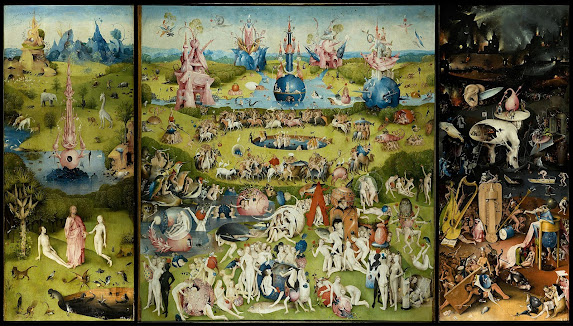Anthony Morelli Baroque Blog
Baroque Art: Caravaggio's Crucifixion of St. Peter
Background
The Crucifixion of Saint Peter is a baroque period painting by Italian artist Caravaggio in 1601 in the city of Rome. It was painted as a commission for the catholic church and was to be displayed in a new chapel that was being built at the time, as since the Council of Trent in the mid-1500s the church was placing emphasis on realistic art that depicted biblical scenes. The Crucifixion of Saint Peter is one such piece, depicting St. Peter being crucified upside down. This solidified him as a martyr in Christendom because he demanded to be crucified upside down due to the fact that he did not see himself as worthy to be killed in the same way as Christ.
Analysis
This piece stood out to me compared to all of the other paintings I've looked at so because of its lack of background and the extreme detail in the figures. The tenebrism is very clear in this piece with the deep dark shadows and light foreground giving an almost intimate feeling to the painting. There is nothing else that can distract you from the subject, no pretty landscape, no small hidden details like in Bosch's works, just the hyper-realistic subject staring you in the face. Speaking of faces, St. Peter's is the only one whose face is clearly visible making you naturally focus on him, additionally, his face is packed full of emotion with a look of pain and sadness. This differs greatly from Renaissance art, whose faces a lot of the time look bland. The last thing I noticed was how unstable everything looks, as if the cross was about to fall over and the men straining as if they could drop it at any moment. My final takeaway is that the Baroque era has very hyper-realistic subjects with dark shadows and often depicted biblical scenes.
References
Wikipedia Contributors. “Crucifixion of Saint Peter (Caravaggio).” Wikipedia, Wikimedia Foundation, 7 Sept. 2019 en.wikipedia.org/wiki/Crucifixion_of_Saint_Peter_(Caravaggio).
Smarthistory. “How to Recognize Baroque Art.” YouTube, 10 May 2016, www.youtube.com/watch?v=EFHPAbHaoqk.
.jpg)


I enjoyed your choice of this iconic masterpiece of baroque art for your blog. Michelangelo Merisi da Caravaggio created the Crucifixion of Saint Peter in 1600-1601. Tiberio Cerasi commissioned it for the Cersai Chapel of Santa Maria del Popolo in Rome. Painting is painted with oil on Canvas and is 230x175cm. Its current location is in the designated Chapel of Santa Maria del Popolo.
ReplyDeletehttps://www.artchive.com/artwork/the-crucifixion-of-saint-peter-michelangelo-merisi-da-caravaggio-1600-1601/
I’m so happy to see someone also choose a “ darker” piece of art. I was tied between the one you picked and a few others. Like i said in my blog post, I tend to lean more towards the darker pieces of art.
ReplyDeletei thought about doing this piece of art for my own blog, but ended up choosing another piece to do. I really like the darker tones and edges in this painting. this painting captures an entire story. the fact that he believed himself to not be worthy of being crucified in the same way as Christ, and opted to be crucified upside-down, speaks measures about this time in history. i'm glad you chose this piece of art instead of me, as I think you were able to describe and explain it a lot better than I would have been able to.
ReplyDelete